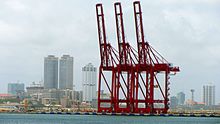Economy of Sri Lanka

|
|
| Currency | Sri Lankan rupee (LKR) |
|---|---|
| Calendar year | |
|
Trade organisations
|
SAFTA, WTO |
| Statistics | |
| GDP | US$ 80.591 Billion (World bank.) / US$ 278.415 Billion PPP |
|
GDP growth
|
4.79% (2015) |
|
GDP per capita
|
US$ 3,818.161 (2015) / US$ 11,068.996 USD PPP |
|
GDP by sector
|
agriculture: 12.8%; industry: 29.2%; services: 58% (2009 est.) |
| 6.9% (2012 est.) | |
|
Population below poverty line
|
4.3% (2011 est.) |
| 36.4 (2013) | |
|
Labour force
|
8,319,680() |
|
Labour force by occupation
|
agriculture: 32.7%; industry: 26.3%; services: 41% (December 2008 est.) |
| Unemployment | 4.3% (2011) |
|
Main industries
|
processing of rubber, tea, coconuts, tobacco and other agricultural commodities; telecommunications, insurance, banking; tourism, shipping; clothing, textiles; cement, petroleum refining, information technology services, construction |
| 110st (2017) | |
| External | |
| Exports | $30.00 billion (2016 est.) |
|
Export goods
|
textiles and apparel, pharmaceuticals, tea, spices, diamonds, emeralds, coconut products, rubber manufactures, fish |
|
Main export partners
|
|
| Imports | $35.00 billion (2016 est.) |
|
Import goods
|
textile fabrics, mineral products, petroleum, foodstuffs, machinery and transportation equipment |
|
Main import partners
|
|
|
FDI stock
|
US$1 Billion (2011) |
|
Gross external debt
|
~$35 billion (2016 est.) or 76% of GDP (2015 est.) |
| Public finances | |
| Revenues | $8.495 billion (2011 est.) |
| Expenses | $12.63 billion (2011 est.) |
|
Standard & Poor's: BB- (Domestic) B+ (Foreign) B+ (T&C Assessment) Outlook: Stable Moody's: B1 Outlook: Stable Fitch: B+ Outlook: Positive |
|
|
Foreign reserves
|
$7.2 billion (17 April 2011 est.) |
With an economy worth $80.591 billion (2015) ($278.415 billion (2017)PPP estimate), and a per capita GDP of about $11,068.996 (PPP), Sri Lanka has mostly had strong growth rates in recent years.The Sri Lankan economy has seen robust annual growth at 6.4 percent over the course of 2003 to 2012, well above its regional peers. In GDP per capita terms, it is ahead of other countries in the South Asian region. Since the end of the three-decade terrorism, Sri Lanka is now focusing on long-term strategic and structural development challenges as it strives to transition to an upper middle income country.
The main economic sectors of the country are tourism, tea export, apparel, textile, rice production and other agricultural products. In addition to these economic sectors, overseas employment contributes highly in foreign exchange, 90% of expatriate Sri Lankans reside in the Middle East.
Sri Lanka has met the Millennium Development Goal (MDG) target of halving extreme poverty and is on track to meet most of the other MDGs, outperforming other South Asian countries. Sri Lanka experienced a big decline in poverty between 2002 and 2009 – from 23 percent to 9 percent of the population. Despite this pockets of poverty continue to exist. An estimated 9 percent of Sri Lankans who are no longer classified as poor live within 20 percent of the poverty line and are, thus, vulnerable to shocks which could cause them to fall back into poverty.
Sri Lanka has one of the lowest tax-to-GDP ratios in the world and creating jobs for the bottom 40% has become a challenge. Sri Lanka also faces a challenges in Social inclusion, Governance and sustainability.
According to Government policies and economic reforms stated by Prime Minister and Minister of National Policy and economic affairs Ranil Wickremesinghe, Sri Lanka plans to create a knowledge based social market economy and an export-oriented economy as well as the Western Region Megapolis a Megapolis in the western province to promote economic growth. Creation of several business and technology development areas specialised in various sectors island wide as well as tourism zones in a planned manner is also being planned.
...
Wikipedia
